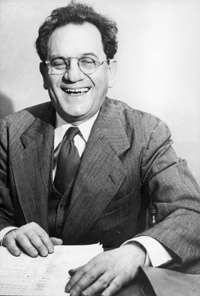Philip Loeb
| Philip Loeb | |
|---|---|
 Philip Loeb | |
| Born |
March 28, 1891 Philadelphia, Pennsylvania, United States |
| Died |
September 1, 1955 (aged 64) New York, New York, United States |
| Spouse(s) | Jeanne La Gue |
Philip Loeb (March 28, 1891 – September 1, 1955), was an American stage, film, and television actor. He was blacklisted under McCarthyism and committed suicide in response.
Background
Born in Philadelphia, Pennsylvania, Loeb first performed in a high school production of Lady Gregory's The Workhouse Ward. He served in the Army, then worked as stage manager of The Green Goddess. His stage career gained strength in the early 1920s when he became associated with the newly formed Theatre Guild in New York City. He worked in a number of plays throughout the decade. His stage work lessened in the 1930s, while he worked with Actors' Equity Association. (It is his work with Equity that is thought to have prompted the charges of Communist leanings.)[1]
In 1948, Loeb portrayed the role of Jake Goldberg on Broadway in Gertrude Berg's play Me and Molly which was based on Berg's long-running radio show The Goldbergs. After the play, he reprised the role on the television adaptation of The Goldbergs on CBS. Loeb became a viewer favorite as the sometimes exasperated but always loving husband Jake to Berg's sometimes meddlesome but always bighearted Molly Goldberg, and it looked as though he would become a television fixture.
Blacklisting
In June 1950, Red Channels: The Report of Communist Influence in Radio and Television, named Loeb as a Communist. Loeb denied being a Communist, but the sponsors of The Goldbergs, General Foods, insisted that he be dropped from the show's cast due to his "controversiality".[2] Berg (who had created the show and owned it on both radio and television) refused to fire Loeb, but Loeb soon resigned, accepting a settlement which was estimated at $40,000.[3][4] Loeb's last acting job was in the 1952 Broadway production of Time Out For Ginger and its subsequent Chicago production in 1954.[5]
Death
In his memoirs, Inside Out, blacklisted screenwriter Walter Bernstein describes Loeb as being disconsolate and depressed as a result of the blacklisting. Loeb was the sole support of a mentally disturbed son, and was burdened with money worries. Bernstein was part of a circle of friends including Zero Mostel, and said "I never saw Loeb smile, even when Zero was at his hilarious best."[6]
The following year Loeb committed suicide by taking an overdose of sleeping pills in the Taft Hotel in midtown New York City on September 1, 1955.[7] No note was found.[1] Loeb was buried in Mount Sinai Cemetery in his native Philadelphia.
Remembrances
Loeb's suicide was reflected in the character Hecky Brown, played by his real-life friend Zero Mostel (himself a blacklisted performer), in Martin Ritt's 1976 film examining the Hollywood blacklist, The Front (also starring Woody Allen). The screenplay of the movie was written by another friend from that era, Walter Bernstein.
Loeb's case is also noted in the Philip Roth novel, I Married a Communist.
The American Academy of Dramatic Arts—where Loeb was an instructor—awards an annual scholarship in his memory. Equity briefly issued the Philip Loeb Humanitarian Award.
References
- 1 2 Philip Loeb Dead; Prominent Actor; Body Found in Midtown Hotel; Overdose of Sleeping Pills Apparent Cause, The New York Times, September 2, 1955 link
- ↑ Actor Is Dropped From Video Cast, The New York Times, January 8, 1952 link
- ↑ "Ousted Video Player Gets 'Goldberg' Fee", The New York Times, January 25, 1952 link
- ↑ "Sponsor". October 8, 1951: 78–79. Retrieved September 2, 2015.
- ↑ Image of Playbill for Chicago show available on Steve McQueen fan site
- ↑ Inside Out: A Memoir of the Blacklist, by Walter Bernstein, Alfred A. Knopf, 1996, p. 185
- ↑ "Autopsy Ordered by Police in Death of Philip Loeb". Broadcasting Telecasting. September 5, 1955: 9. Retrieved September 2, 2015.
External links
- Philip Loeb at the Internet Broadway Database

- Philip Loeb at the Internet Movie Database
- Find A Grave memorial